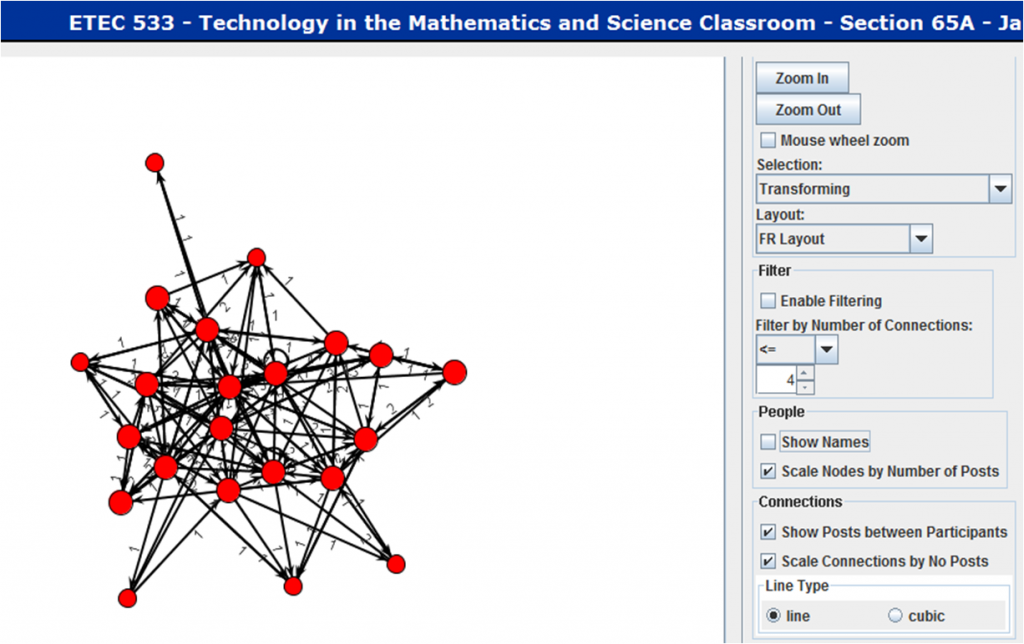Yesterday I had a chance to attend a very interesting presentation by one of my University of British Columbia Colleagues, Dr. Leah Macfadyen, who introduced me to a very interesting tool that you also might want to try. The tool is called SNAPP (Social Networking Adapting Pedagogical Practice) and it was developed by Shane Dawson’s team in Australia. You can find more about it here. The idea behind this tool is to use the tracking information Class Management Systems store (sometimes also called Learning Management Systems, such as Blackboard, WebCT, Moodle, etc.) to visualize the interactions your students are having via the Discussion Board. This is especially crucial fro online courses. Notice, if you just go by the number of posts, or the number of messages your students read or write, you might get very distorted information: we all know the quantity is not always the same as the quality. However, if you look at how they interact with other students, how often their posts get responses, you might see a different picture. As soon as I came back from this presentation (around 8 PM), I went to my office to try it out. I wanted to see if my students are actively engaged in the discussion and wanted to make sure I DO NOT MONOPOLIZE the floor. I also wanted to see if I have outliers either falling behind or monopolizing the discussion that I was not aware of. As I am having only 19 students in my class, I feel that I know all of them virtually (I have never seen my students in real life). Over the past month I already noticed that a few of them are not very active, yet I could not read 100% of all the posts (almost 2000 now). In addition, since this is my first online course after all, I was worried that I intervene too much and do not allow all my students to take active part in the discussion. So to be honest, I was a little bit nervous before trying it out. So here is a snapshot from a real picture of the discussion from my class. I removed all the students’ names for this post, but the software allows you to have them displayed. As you can see, you cannot identify where my dot is (which is great news – the world does not revolve around me). You ca also see that all the students participate in the discussion with only one of them being significantly less active (actually this person is catching up now). In addition, you can see that most of the dots (2/3 of them) have more or less the same size, except for the 6 dots on the outskirts of the graph. This means that this diagram shows me who are the students who are not as engaged in the discussion and now I can contact them personally. In addition, I will share this snapshot with my students, as I think it is important for them to see it. I think it is a very interesting tool for the teacher and for the students, especially for online classes and for large classes using course management systems. I hope you will also enjoy this tool!


Hi Dr. M
I asked for the link back in the course site before I checked this out. Sorry..
Having reviewed this and knowing the issues I deal with in my own class of 65, in spite of the temptation to use a tool to manage a very complex part of my online courses, I will not elect this for now. It is not helpful where I need to dig in as instructor–that is the content of the posts and whether the posting reflects inquiry, deeper understanding, and analysis with engagement at a level appropriately directly with the thread assigned work. nice to check it out though! Kathleen
Hi Kathleen,
I am glad you commented as you are a very experienced online instructor. I am not sure if any ONE TOOL can solve this problem – of measuring student engagement. However, I think that this tool might be helpful as one of them. I do think a teacher should read the posts and comment, yet it might be helpful to see very quickly the dynamics of student interaction. Then when you notice some interesting patterns you might want to go deeper and see what is going on. For example, a student who takes over the discussion board will appear very clearly on the SNAPP graph and may be showing her/him the picture will help her or him see what is going on? Just an idea.
Regards, M.